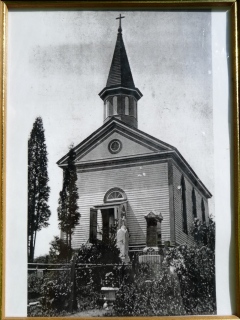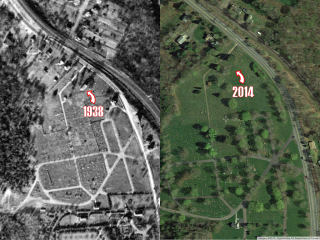TT 2 J
Spatial/elevation data
| Coordinates | N 41.33388° W 75.515962° (estimate) |
| Elevation | Unknown |
| Location | Pennsylvania
Lackawanna County Moscow Quad |
Mark description
| Type | Transit Traverse Station Disk | ||||||
| Setting | Rock Outcrop | ||||||
| Monumented | 1926 by USGS | ||||||
| Description (USGS) | Moscow, 0.2 mi S. of overhead crossing of Delaware, Lackawanna & Western RR.; 40 ft W. of hwy.; 40 ft S. of concrete steps to St. Catherine Church,; in rock outcrop; standard tablet stamped “TT STA NO 2 J 1926”
|
Narrative and photographs
We looked for this one briefly a few weeks ago with Dad. The three of us spread out and searched the entire hillside near the road, from one end to the other, without any luck. We found plenty of small outcrops that could have been good settings for a mark, but there was no mark to be found. Without knowing where the church had once stood, we didn’t have much information to go on.
Today we brought our documentation to the caretaker’s building. We were fortunate to find there the groundskeeper, who had worked at the cemetery for many years! We thought for sure he would know of the disk if it was obvious. He didn’t, but he was very talkative and most willing to give us any information that could be helpful. Our first point of confusion concerned the location of the former church. Where, exactly, was it?
The groundskeeper hadn’t been around quite that long, but he pulled a framed photograph off the wall and said “I have an idea where it is, and this should help us figure it out!” I just love this kind of thing. We were able to use the two prominent grave monuments shown in the photo (which, of course, still exist) to determine where the church had been and how it was oriented.
The current St. Catherine’s Church is located on Church Street in the center of Moscow. That church was built in 1923. The first church was in the cemetery, and it is this church that the mark was near. It’s not clear when the first church was built or when (or how) it was destroyed.


